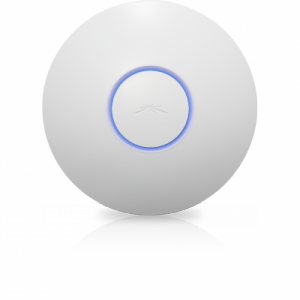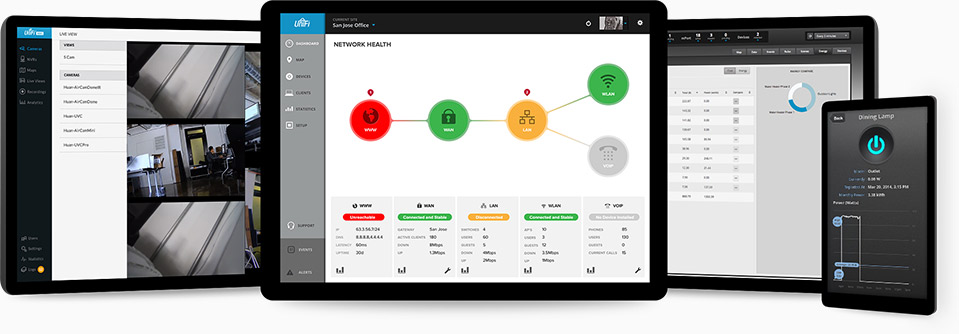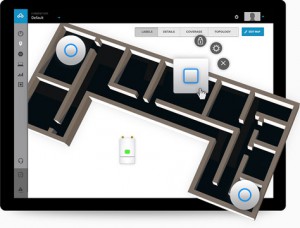A few years ago I was struggling with some crap WLAN access point from hell. It was slow, the configuration options were rubbish and the signal coverage was way beyond what I was looking for.
So I started to look out for some better alternatives. If you’re looking for something more “enterprisy”, you’ll definitely land on a Cisco page sooner or later. The only problem is, I’m not a huge fan of Cisco (wireless) hardware, and the price tag was quite… interesting. So I kept looking and found an alternative.
Ubiquiti Networks
There’s an American technology company called Ubiquiti Networks, which started their business in 2005. They’re primarily focusing on wireless hardware and they started with some wireless antennas. But soon they realised that there’s a market between these “crappy” wireless access points you find in every consumer electronics market, and the big enterprise products which Cisco was selling. This was the time when the UniFi AP was born.
UniFi AP
Let’s see, what can I tell you about the UniFi AP. Basically it’s just like any other WLAN access point, but it just works… it works well… really well! But let’s dig into that.
 Design
Design
When it comes to mount something like an access point on the wall, it shouldn’t look like a cheap plastic thingy. I think the designers of the UniFi AP did a very decent job.
It looks like an UFO and there’s a really nice LED ring on the middle of the device, which shows you the state of the AP. You’re annoyed by those fancy bright LEDs on all new devices? Then don’t bother, because the light emitting from the LED ring is really clear, but not that bright. But if you don’t like it, you can even turn it off.
Apparently the designer thought about the cables as well, because there’s only one PoE powered Ethernet port on the back of the AP.
Functionality
Functionality is where it gets interesting and where Ubiquiti Networks got me. This thing is frickin’ amazing! Here’s a short intro what this thing is capable of:
- Scalability: Just add hundreds of access points to your environment and you’re still fine.
- Deployment: The installation is plug and play and you don’t need to have to be very experienced for that.
- Configuration WebUI: Manage all your access points in one single web interface.
- Dual-band WiFi: Based on the version you buy, you get dual-band wireless (2.4 GHz / 5 GHz).
- VLAN support: Just add tagged VLANs to your access point and map them to your WLAN networks.
- Multiple WLANs: Of course you’re configure more than just one simultaneous WLAN network.
- Guest portal: Enable an open, password-protected or voucher-based portal for your guests. You can even limit the traffic.
- Roaming: Enable zero-handoff roaming and you’re clients will seamlessly switch from one AP to another.
As you can see these products were not only made for private use, they’ve made them for enterprise businesses as well. If you now think these devices must be expensive as hell, I’ve to disappoint you. The official MSRP is under CHF/USD 100.
Controller
To configure the access points, you need the UniFi controller software. It’s free, downloadable from their website, based on Java and runs on Linux, Mac OS X and Windows. The controller is the “central” management interfaces for all your access points. Basically you start your controller application, point your web browser to the controllers WebUI and start configuring your devices.

The nice thing I already mentioned before, all the devices are plug and play, which means you can simply connect the AP to your network. After about a minute you’ll see the orphan AP popping up in your controller WebUI, where you can click adopt and it will automatically be configured for your environment.
Even if you’re looking forward for a “wireless uplink” AP which functions as wireless repeater, you’ll be surprised how easy that is. Just connect your new AP to the network (via Ethernet), click adopt, then disconnect it from the network and mount it to the wall/ceiling. After a minute the controller alerts you about the missing AP, where you can select a “search for missing AP via wireless uplink” mode. All other APs will then search for the missing AP via wireless and automatically build an uplink when they found it. And this works like a charm, because the missing AP already exchanged the secret key with the controller. Awesome, isn’t it?
The configuration of your WLANs is dead simple as well. You’ll configure your desired WLANs and put them in a WLAN group. Each of your APs has one of these WLAN groups assigned and will function as access point in the network. Of course you can select between different security modes (from open to WPA2 enterprise), traffic shaping and attach guest portals to it. Guest portals are a great way to give your guests limited access to your network, by putting them into an own guest VLAN, scheduling the WLAN availability by time and even use vouchers.
 You can also use custom maps and Google Maps to display the location of your UniFi AP devices. This is really nice for huge facilities where you’ve to configure a huge amount of access points.
You can also use custom maps and Google Maps to display the location of your UniFi AP devices. This is really nice for huge facilities where you’ve to configure a huge amount of access points.
What I also like on the controller is the ability to push configuration changes (e.g. WLAN groups, traffic limits, schedules) to your devices with a single click. Even software / firmware updates are working like magic with no intervention at all.
When it comes to performance monitoring and issue tracking, Ubiquiti Networks did an awesome job. Hell I never saw such a beautiful designed monitoring platform for network devices anywhere else. You’ll get informations about your traffic, connected devices, guests, failed logins, missing APs and stuff like that. All packed into this amazing WebUI. Even rouge access points will be displayed and you can kick/ban “bad” clients with a single click, after you’ve attached a private note to them. You want your logs externally in your log server, for example Splunk? No problem, just configure the syslog server and you’re fine.
Conclusion
Stop using crappy WiFi products and give Ubiquiti Networks a chance. They’re a young and dynamic company, building remarkable products for a really fair price tag. They also have a great community and you’ll find a lot of fans in the forums as well.
If you start using UniFi APs you’ll find yourself smiling at the end of the day and kicking out all your other WiFi hardware.
To be honest, this is how IT should work and these guys are always my example of how products have to be built!

9 Comments